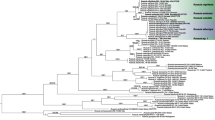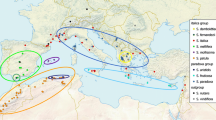Abstract
Distinguishing individual Russula species can be very difficult due to extensive phenotypic plasticity and obscure morphological and anatomical discontinuities. In this study, we use the internal transcribed spacer (ITS) and 28S nuclear ribosomal large subunit (LSU) markers to identify and study the genetic diversity of species in the Russula subgenus Compacta in Korea. We focus on two morphologically similar species that are often misidentified for each other: R. nigricans and R. subnigricans. Based on molecular phylogenetic analyses, we identify three subgroups of R. nigricans, with two from Asia and one from Europe/North America. Surprisingly, we find Korean R. subnigricans are more closely related to R. eccentrica from North America than the type specimen of R. subnigricans from Japan. These molecular data, along with habitat data, reveal that Korean R. subnigricans had previously been misclassified and should now be recognized as R. eccentrica. Both ITS and LSU exhibit high interspecific and low intraspecific variation for R. eccentrica, R. nigricans, and R. subnigricans. These markers provide enough resolutional power to differentiate these species and uncover phylogeographic structure, and will be powerful tools for future ecological studies of Russula.
Similar content being viewed by others
References
Anderson, J.B. and Stasovski, E. 1992. Molecular phylogeny of northern hemisphere species of Armillaria. Mycologia 84, 505–516.
Bills, G.F. 1985. Southern Applachian Russulas. III. The identity of Russula eccentrica and R. Morgani (Russulaceae). Brittonia 37, 360–365.
Bills, G., Holtzman, G., and Miller, O. Jr. 1986. Comparison of ectomycorrhizal-basidiomycete communities in red spruce versus northern hardwood forests of West Virginia. Can. J. Bot. 64, 760–768.
Bok, J. and Shin, G. 1986. Taxonomic studies on the genus Russula of Korea. Kor. J. Mycol. 14, 237–244.
Buyck, B. and Ovrebo, C.L. 2002. New and interesting Russula species from Panamá. Mycologia 94, 888–901.
Chen, Y.C., Eisner, J.D., Kattar, M.M., Rassoulian-Barrett, S.L., Lafe, K., Bui, U., Limaye, A.P., and Cookson, B.T. 2001. Polymorphic internal transcribed spacer region 1 DNA sequences identify medically important yeasts. J. Clin. Microbiol. 39, 4042–4051.
Chun, J. 1995. Computer assisted classification and identification of actinomycetes (Doctoral thesis). University of Newcastle.
Darriba, D., Taboada, G.L., Doallo, R., and Posada, D. 2012. ModelTest 2: more models, new heuristics and parallel computing.Nat. Methods 9, 772.
Eberhardt, U. 2002. Molecular kinship analyses of the agaricoid Russulaceae: correspondence with mycorrhizal anatomy and sporocarp features in the genus Russula. Mycol. Prog. 1, 201–223.
Fell, J.W., Boekhout, T., Fonseca, A., Scorzetti, G., and Statzell-Tallman, A. 2000. Biodiversity and systematics of basidiomycetous yeasts as determined by large-subunit rDNA D1/D2 domain sequence analysis. Int. J. Syst. Evol. Microbiol. 50, 1351–1371.
Fogel, R. and Trappe, J.M. 1978. Fungus consumption (mycophagy) by small animals. Northwest Sci. 52, 1–31.
Gardes, M. and Dahlberg, A. 1996. Mycorrhizal diversity in arctic and alpine tundra: an open question. New Phytol. 133, 147–157.
Geml, J., Laursen, G.A., Herriott, I.C., McFarland, J.M., Booth, M.G., Lennon, N., Chad Nusbaum, H., and Lee Taylor, D. 2010. Phylogenetic and ecological analyses of soil and sporocarp DNA sequences reveal high diversity and strong habitat partitioning in the boreal ectomycorrhizal genus Russula (Russulales; Basidiomycota). New Phytol. 187, 494–507.
Guo, W. 1992. Resources of wild edible fungi in Tibet, China. Zhongguo Shiyonjun 11, 33–34.
Hinrikson, H.P., Hurst, S.F., Lott, T.J., Warnock, D.W., and Morrison, C.J. 2005. Assessment of ribosomal large-subunit D1-D2, internal transcribed spacer 1, and internal transcribed spacer 2 regions as targets for molecular identification of medically important Aspergillus species. J. Clin. Microbiol. 43, 2092–2103.
Hongo, T. 1955. Notes on Japanese larger fungi. J. Jpn. Bot. 30, 73–79.
Hu, L. and Zeng, L. 1992. Investigation on wild edible mushroom resources in Wanxian Country, Sichuan Province. Zhongguo Shiyongjun 11, 35–37.
Imazeki, R. and Hongo, T. 1989. Colored illustrations of mushrooms of Japan, vol. II. Hoikusha, Osaka, Japan.
James, T.Y., Moncalvo, J.M., Li, S., and Vilgalys, R. 2001. Polymorphism at the ribosomal DNA spacers and its relation to breeding structure of the widespread mushroom Schizophyllum commune. Genetics 157, 149–161.
Katoh, K., Misawa, K., Kuma, K.i., and Miyata, T. 2002. MAFFT: a novel method for rapid multiple sequence alignment based on fast Fourier transform. Nucleic Acids Res. 30, 3059–3066.
Kirk, P.M., Cannon, P.F., Minter, D., and Stalpers, J.A. 2008. Dictionary of the Fungi. CABI, Wallingford, UK.
Kleine, C.S., McClean, T., and Miller, S.L. 2013. Genetic divergence among disjunct populations of three Russula spp. from Africa and Madagascar. Mycologia 105, 80–89.
Kränzlin, F. 2005. Fungi of Switzerland. Vol. 6: Russulaceae. Mykologia, Luzern, Switzerland.
Kwon, D.J. and Bae, Y.S. 2010. Chlorinated hydroquinone derivatives of fruiting body of Russula subnigricans. Mokchae Konghak 38, 439–443.
Lee, P.T., Wu, M.L., Tsai, W.J., Ger, J., Deng, J.F., and Chung, H.M. 2001. Rhabdomyolysis: an unusual feature with mushroom poisoning. Am. J. Kidney Dis. 38, 1–5.
Lickey, E.B., Hughes, K.W., and Petersen, R.H. 2002. Biogeographical patterns in Artomyces pyxidatus. Mycologia 94, 461–471.
Miller, S.L. and Buyck, B. 2002. Molecular phylogeny of the genus Russula in Europe with a comparison of modern infrageneric classifications. Mycol. Res. 106, 259–276.
Nilsson, R.H., Kristiansson, E., Ryberg, M., Hallenberg, N., and Larsson, K.H. 2008. Intraspecific ITS variability in the kingdom Fungi as expressed in the international sequence databases and its implications for molecular species identification. Evol. Bioinform. Online 4, 193–201.
Park, W. and Lee, H. 2011. Wild fungi of Korea. Kyo-Hak Publishing Co., Seoul, Korea.
Peck, C.H. 1911. New species and varieties of extralimital fungi. N.Y. State Mus. Bull. 150, 50–65.
Rambaut, A. and Drummond, A. 2009. Tracer v1.5 Available from http://tree.bio.ed.ac.uk/software/tracer/.
Rogers, S.O. and Bendich, A.J. 1994. Extraction of total cellular DNA from plants, algae and fungi, pp. 183–190. In Gelvin, S.B. and Schilperoort, R.A. (eds.), Plant molecular biology manual, Kluwer Academic Publishers, Boston, USA.
Romagnesi, H. 1996. Les russules ďEurope et ďAfrique du Nord. Gantner, Vadug.
Ronquist, F., Teslenko, M., van der Mark, P., Ayres, D.L., Darling, A., Höhna, S., Larget, B., Liu, L., Suchard, M.A., and Huelsenbeck, J.P. 2012. MrBayes 3.2: efficient Bayesian phylogenetic inference and model choice across a large model space. Syst. Biol. 61, 539–542.
Schoch, C.L., Seifert, K.A., Huhndorf, S., Robert, V., Spouge, J.L., Levesque, C.A., Chen, W., Bolchacova, E., Voigt, K., and Crous, P.W. 2012. Nuclear ribosomal internal transcribed spacer (ITS) region as a universal DNA barcode marker for Fungi. Proc. Natl. Acad. Sci. USA 109, 6241–6246.
Scorzetti, G., Fell, J., Fonseca, A., and Statzell-Tallman, A. 2002. Systematics of basidiomycetous yeasts: a comparison of large subunit D1/D2 and internal transcribed spacer rDNA regions. FEMS Yeast Res. 2, 495–517.
Shaffer, R.L. 1962. The subsection compactae of Russula. Brittonia 14, 254–284.
Shimono, Y., Kato, M., and Takamatsu, S. 2004. Molecular phylogeny of Russulaceae (Basidiomycetes; Russulales) inferred from the nucleotide sequences of nuclear large subunit rDNA. Mycoscience 45, 303–316.
Singer, R. 1986. The Agaricales in modern taxonomy. Koeltz Scientific Books, Koenigstein, Germany.
Stockinger, H., Krüger, M., and Schüßler, A. 2010. DNA barcoding of arbuscular mycorrhizal fungi. New Phytol. 187, 461–474.
Vasaitis, R., Menkis, A., Lim, Y.W., Seok, S., Tomsovsky, M., Jankovsky, L., Lygis, V., Slippers, B., and Stenlid, J. 2009. Genetic variation and relationships in Laetiporus sulphureus s. lat., as determined by ITS rDNA sequences and in vitro growth rate. Mycol. Res. 113, 326–336.
Vasiliauskas, R., Johannesson, H., and Stenlid, J. 1999. Molecular relationships within the genus Amylostereum as determined by internal transcribed spacer sequences of the ribosomal DNA. Mycotaxon 71, 155–161.
Vilgalys, R. and Hester, M. 1990. Rapid genetic identification and mapping of enzymatically amplified ribosomal DNA from several Cryptococcus species. J. Bacteriol. 172, 4238–4246.
Villeneuve, N., Grandtner, M.M., and Fortin, J.A. 1989. Frequency and diversity of ectomycorrhizal and saprophytic macrofungi in the Laurentide Mountains of Quebec. Can. J. Bot. 67, 2616–2629.
Weber, N.S., Smith, A.H., and Guravich, D. 1985. A field guide to southern mushrooms. University of Michigan Press, Michigan, USA.
White, T.J., Bruns, T., Lee, S., and Taylor, J.W. 1990. Amplification and direct sequencing of fungal ribosomal RNA genes for phylogenetics, pp. 315–322. In Innis, M.A., Gelfand, D.H., Sninsky, J.J., and White, T.J. (eds.), PCR protocols: a guide to methods and applications. Academic Press, Inc., San Diego, USA.
Yamashita, S. and Hijii, N. 2007. The role of fungal taxa and developmental stage of mushrooms in determining the composition of the mycophagous insect community in a Japanese forest. Eur. J. Entomol. 104, 225–233.
Yun, J.H., Kim, J.H., Oh, K.H., and Lee, B.Y. 2011. Distributional change and climate condition of warm-temperate evergreen broad-leaved trees in Korea. Korean J. Environ. Ecol. 25, 47–56.
Author information
Authors and Affiliations
Corresponding author
Rights and permissions
About this article
Cite this article
Park, M.S., Lee, H., Oh, SY. et al. Species delimitation of three species within the Russula subgenus Compacta in Korea: R. eccentrica, R. nigricans, and R. subnigricans . J Microbiol. 52, 631–638 (2014). https://doi.org/10.1007/s12275-014-4168-z
Received:
Revised:
Accepted:
Published:
Issue Date:
DOI: https://doi.org/10.1007/s12275-014-4168-z




